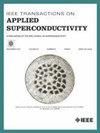Analysis on the Bending Performance of a High-Current Superconducting CORC-Type Cable
IF 1.8
3区 物理与天体物理
Q3 ENGINEERING, ELECTRICAL & ELECTRONIC
引用次数: 0
Abstract
There are various types of high-current high-temperature superconducting (HTS) cables by using of REBCO tape. Cable on round core (CORC) is a high current HTS cable using REBCO tape, known for its high current carrying capacity and flexibility. CORC cables are subjected to various mechanical stresses during operation, including bending stresses during cabling, winding, and cryocooling. Due to the multilayer structure of high current CORC, the study of the bending characteristics of CORC cables has become more important. In order to investigate the current carrying and bending properties of the CORC cable, the 2-D critical current simulation of a 24-layer CORC-type cable is carried out to analyze the self-field distribution and current density distribution, and the calculated critical current of the cable under self-field at 77 K is about 5734 A. Subsequently, several samples were fabricated and tested at 77 K. The influence of bending stress on the critical current of CORC-type cable was studied to determine the critical bending radius of CORC-type cable. The results show that the maximum critical current of the 24-layer CORC-type cable under self-field at 77 K is 5.9 kA, and the critical bending radius is less than 50 mm, demonstrating the high current capacity and flexibility of the large-current CORC-type cable.大电流超导corc型电缆弯曲性能分析
采用REBCO胶带制成的大电流高温超导(HTS)电缆种类很多。圆芯电缆(CORC)是一种采用REBCO胶带的大电流高温超导电缆,以其高载流能力和灵活性而闻名。CORC电缆在使用过程中会受到各种机械应力,包括布放、缠绕和冷冻过程中的弯曲应力。由于大电流CORC的多层结构,对CORC电缆弯曲特性的研究变得更加重要。为了研究CORC电缆的载流性能和弯曲性能,对24层CORC型电缆进行了二维临界电流模拟,分析了自场分布和电流密度分布,计算得到自场作用下电缆在77 K时的临界电流约为5734 a。随后,制作了几个样品并在77 K下进行了测试。研究了弯曲应力对corc型电缆临界电流的影响,确定了corc型电缆的临界弯曲半径。结果表明:在77 K自场作用下,24层corc型电缆的最大临界电流为5.9 kA,临界弯曲半径小于50 mm,显示了大电流corc型电缆的高容量和柔性;
本文章由计算机程序翻译,如有差异,请以英文原文为准。
求助全文
约1分钟内获得全文
求助全文
来源期刊

IEEE Transactions on Applied Superconductivity
工程技术-工程:电子与电气
CiteScore
3.50
自引率
33.30%
发文量
650
审稿时长
2.3 months
期刊介绍:
IEEE Transactions on Applied Superconductivity (TAS) contains articles on the applications of superconductivity and other relevant technology. Electronic applications include analog and digital circuits employing thin films and active devices such as Josephson junctions. Large scale applications include magnets for power applications such as motors and generators, for magnetic resonance, for accelerators, and cable applications such as power transmission.
 求助内容:
求助内容: 应助结果提醒方式:
应助结果提醒方式:


